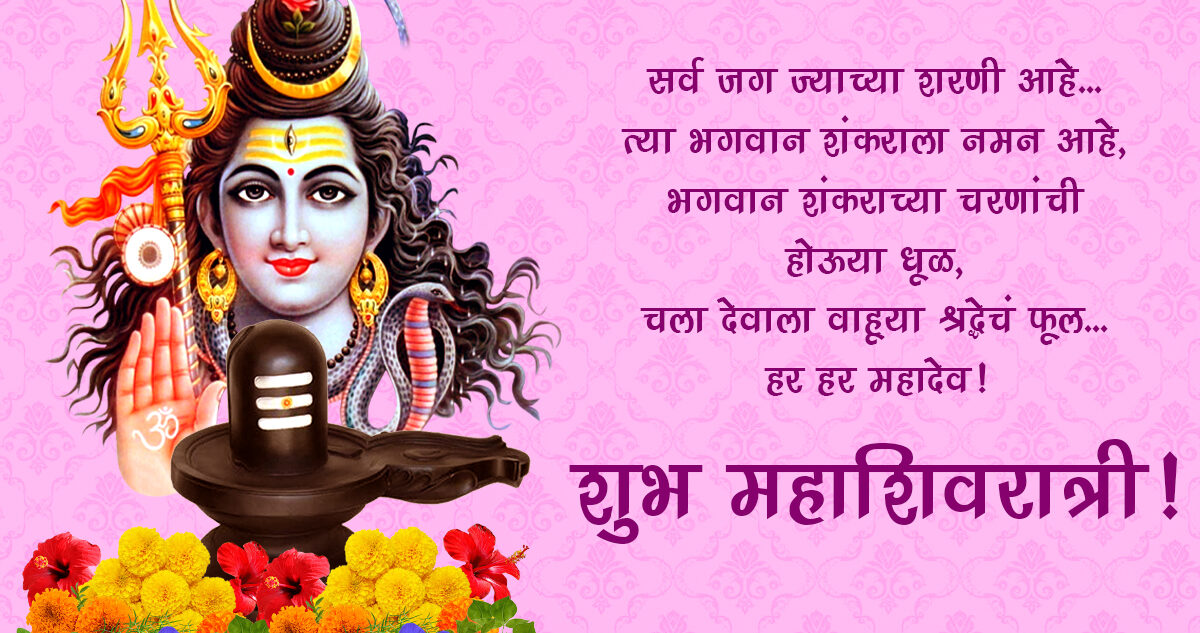महाशिवरात्रीच्या हार्दिक शुभेच्छा |
Maha Shivratri Wishes in Marathi 2024
“चिंतेने ना कधी ग्रासू द्यावे आपुले मन,
शंभुमय व्हावे सदा प्रत्येक भक्ताचे मन
मग निश्चित सुखी होतील सर्वजण
घेऊन शंकराचेनाम चिंता मुक्त करावे मन
महाशिवरात्रीच्या खास शुभेच्छा”
“दुख दारिद्रय नष्ट होवो
सुख समृद्धी दारी येवो या
महाशिवरात्रीच्या शुभ दिवशी
तुमच्या सर्व मनोकामना पूर्ण होवो
महाशिवरात्रीच्या हार्दिक शुभेच्छा”

“ज्या अडचणीवर नसतो कुठला उपाय
त्यावेळी फक्त नामस्मरण हाच एक तोडगा
म्हणा ऊॅं नम: शिवाय
महाशिवरात्रीच्या खूप खूप शुभेच्छा”
“शिव शंकरांचा महिमा अपरंपार !
शिव करतात सर्वांचा उद्धार,
त्यांची कृपा तुमच्यावर नेहमी असो,
आणि भोले शंकर आपल्या जीवनात नेहमी
आनंदच आनंद देवो…
महाशिवरात्रीच्या शुभेच्छा!”
“बेलाचे पान वाहतो महादेवाला
करतो वंदन दैवताला
सदा सुखी ठेव माझ्या प्रिय जनांना
हिच प्रार्थना शिव शंभो शंकराला.”
“कारुण्य सिंधु भव दु:ख हारी..
तुज विण शंभु मज कोण तारी…
हर हर महादेव
महाशिवरात्रीच्या हार्दिक शुभेच्छा !”
“त्रिशुलधारी त्रिग्रही योगात प्रसन्न झाले
शिवभक्त दारी आले
हर हर महादेवाचा गजर झाला,
होवो उद्धार सर्वांचा
महाशिवरात्रीच्या हार्दिक हार्दिक शुभेच्छा”
March 2024, Maha Shivratri will occur, and it is important to be aware of the precise date and Puja timings
Maha Shivratri is scheduled for March 8, 2024. According to Drik Panchang, the celebration of Maha Shivratri will commence on the Chaturdashi Tithi on the night of March 8 and conclude on the evening of March 9. Chaturdashi Tithi will commence at 09:57 pm on March 8, 2024, and conclude at 06:17 pm on March 9, 2024. The Nishita Kaal Puja Time is set to start at 12:07 am and conclude at 12:56 am on March 9.
The story of Maha Shivratri
Maha Shivratri, a profoundly revered Hindu festival, commemorates the divine union of Lord Shiva and Maa Parvati, alongside various cosmic events linked to Lord Shiva. According to Hindu mythology, Lord Shiva entered into matrimony with Maa Shakti, his celestial consort, on this propitious night. The celebration is known as ‘The Night of Lord Shiva,’ paying homage to their sacred union. In this symbolism, Lord Shiva embodies Purusha, representing mindfulness, while Maa Parvati embodies Prakriti, representing nature. The convergence of consciousness and energy during their union is believed to be instrumental in the process of creation.
Another myth narrates that during the genesis of the universe, Lord Shiva took on the form of Lord Rudra on the midnight of Maha Shivaratri, following the blessings of Lord Brahma. It is also recounted that on this night, Lord Shiva performed the cosmic dance encompassing creation, preservation, and destruction, prompted by the tragic immolation of his consort, Maa Sati. This divine dance, known as Rudra Tandav, holds profound significance among devotees.

According to Drik Panchang, amidst the churning of the great ocean, poisonous substance surfaced with the potential to annihilate the entire creation. In an act of selflessness, Lord Shiva consumed the poison, thus shielding the world from impending destruction. Consequently, Maha Shivaratri is observed by Lord Shiva’s devotees as an expression of gratitude for his pivotal role in preserving the universe.
Importance of Mahashivratri
Mahashivratri holds profound significance for individuals navigating the spiritual journey, as well as those deeply engaged in family life and ambitious pursuits. In familial contexts, Mahashivratri is celebrated as the commemoration of Shiva’s wedding anniversary, while those driven by worldly aspirations perceive it as the day when Shiva achieved victory over his adversaries.
Yet, for ascetics, Mahashivratri symbolizes the day when Shiva attained oneness with Mount Kailash, embodying a state of absolute stillness. In the yogic tradition, Shiva is not merely venerated as a deity but is revered as the Adi Guru, the primary teacher from whom the science of Yoga originated. Following countless years of meditation, he reached a point of complete stillness, a moment acknowledged as Mahashivratri. On this night, all internal movement ceased, leaving him in a state of profound stillness. Ascetics, therefore, perceive Mahashivratri as a night of deep and transformative stillness.

Shivratri – The Night of Spiritual Significance
Shivratri, is the darkest day of the month. Celebrating Shivratri on a monthly basis, and the particular day, Mahashivratri, almost seems like celebration of darkness. Any logical mind would resist darkness and naturally opt for light. But the word “Shiva” literally means that which is not. That which is not is Shiva. “That which is not” means, if you open your eyes and look around, if your vision is for small things, you will see lots of creation. If your vision is really looking for big things, you will see the biggest presence in the existence is a vast emptiness.
A few spots which we call galaxies are generally much noticed, but the vast emptiness that holds them does not come into everybody’s notice. This vastness, this unbounded emptiness, is what is referr to as Shiva. Today, modern science also proves that everything comes from nothing and goes back to nothing. It is in this context that Shiva, the vast emptiness or nothingness, is referred to as the great lord, or Mahadeva.
Every religion, every culture on this planet has always been talking about the omnipresent, all-pervading nature of the divine. If we look at it, the only thing that can be truly all-pervading, the only thing that can be everywhere is darkness, nothingness, or emptiness.
Generally, when people are seeking well-being, we talk of the divine as light. When people are no longer seeking well-being, when they are looking beyond their life in terms of dissolving, if the object of their worship and their sadhana is dissolution, then we always refer to the divine as darkness.
Significance of Shivratri
Light is a fleeting phenomenon in the realm of consciousness. It is not eternal; instead, it represents a limited possibility, emerging and concluding within a finite timeframe. The most prominent source of light on our planet is the sun. Even the sun’s radiance can be obstruct by a simple hand, leaving a shadow of darkness in its wake. In contrast, darkness is all-encompassing and omnipresent.
Throughout history, less mature minds have often associated darkness with malevolence, labeling it as the embodiment of evil. However, when we describe the divine as all-pervading, we are essentially attributing divinity to darkness, as darkness requires no external support. It exists independently and is omnipresent, embodying an intrinsic quality that needs no external validation.
Light invariably originates from a source that is in the process of burning itself out. It possesses a defined beginning and end, always emanating from a limited reservoir. In contrast, darkness lacks a specific source; it is a self-contained essence that pervades every space, exhibiting omnipresence.
Also Read : Top 10 MLM Company In India
In Indian culture, ancient prayers were not center around self-preservation, protection, or material improvement. Instead, these prayers consistently implored the divine with sentiments like, “Oh lord, obliterate my limited self so that I may transcend and become one with your boundless existence.” Thus, when we observe Shivratri, the darkest night of the month, it symbolizes an opportunity for individuals to dissolve their limitations and immerse themselves in the boundless essence of the creative source, which resides as a dormant seed within every human being.










